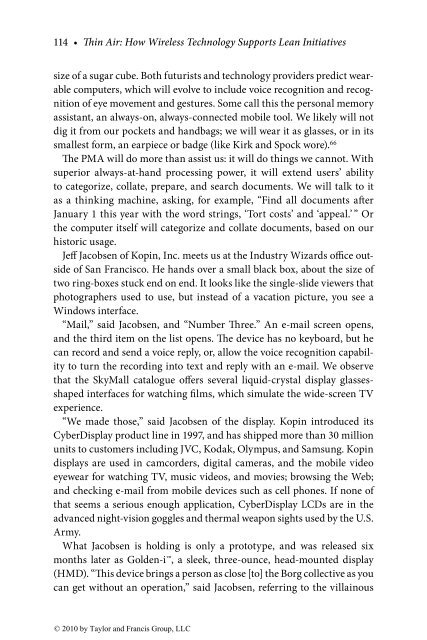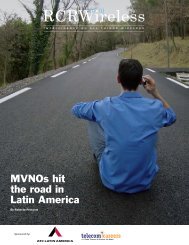Thin Air: How Wireless Technology Supports Lean ... - Prepaid MVNO
Thin Air: How Wireless Technology Supports Lean ... - Prepaid MVNO
Thin Air: How Wireless Technology Supports Lean ... - Prepaid MVNO
Create successful ePaper yourself
Turn your PDF publications into a flip-book with our unique Google optimized e-Paper software.
114 • <strong>Thin</strong> <strong>Air</strong>: <strong>How</strong> <strong>Wireless</strong> <strong>Technology</strong> <strong>Supports</strong> <strong>Lean</strong> Initiatives<br />
size of a sugar cube. Both futurists and technology providers predict wearable<br />
computers, which will evolve to include voice recognition and recognition<br />
of eye movement and gestures. Some call this the personal memory<br />
assistant, an always-on, always-connected mobile tool. We likely will not<br />
dig it from our pockets and handbags; we will wear it as glasses, or in its<br />
smallest form, an earpiece or badge (like Kirk and Spock wore). 66<br />
The PMA will do more than assist us: it will do things we cannot. With<br />
superior always-at-hand processing power, it will extend users’ ability<br />
to categorize, collate, prepare, and search documents. We will talk to it<br />
as a thinking machine, asking, for example, “Find all documents after<br />
January 1 this year with the word strings, ‘Tort costs’ and ‘appeal.’ ” Or<br />
the computer itself will categorize and collate documents, based on our<br />
historic usage.<br />
Jeff Jacobsen of Kopin, Inc. meets us at the Industry Wizards office outside<br />
of San Francisco. He hands over a small black box, about the size of<br />
two ring-boxes stuck end on end. It looks like the single-slide viewers that<br />
photographers used to use, but instead of a vacation picture, you see a<br />
Windows interface.<br />
“Mail,” said Jacobsen, and “Number Three.” An e-mail screen opens,<br />
and the third item on the list opens. The device has no keyboard, but he<br />
can record and send a voice reply, or, allow the voice recognition capability<br />
to turn the recording into text and reply with an e-mail. We observe<br />
that the SkyMall catalogue offers several liquid-crystal display glassesshaped<br />
interfaces for watching films, which simulate the wide-screen TV<br />
experience.<br />
“We made those,” said Jacobsen of the display. Kopin introduced its<br />
CyberDisplay product line in 1997, and has shipped more than 30 million<br />
units to customers including JVC, Kodak, Olympus, and Samsung. Kopin<br />
displays are used in camcorders, digital cameras, and the mobile video<br />
eyewear for watching TV, music videos, and movies; browsing the Web;<br />
and checking e-mail from mobile devices such as cell phones. If none of<br />
that seems a serious enough application, CyberDisplay LCDs are in the<br />
advanced night-vision goggles and thermal weapon sights used by the U.S.<br />
Army.<br />
What Jacobsen is holding is only a prototype, and was released six<br />
months later as Golden-i, a sleek, three-ounce, head-mounted display<br />
(HMD). “This device brings a person as close [to] the Borg collective as you<br />
can get without an operation,” said Jacobsen, referring to the villainous<br />
© 2010 by Taylor and Francis Group, LLC
















